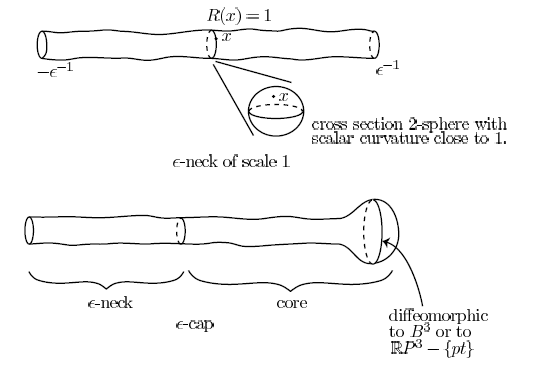Suppose $M$ is a 3-dimensional manifold, John W. Morgan and Frederick Tsz-Ho Fong in their "Ricci Flow and Geometrization of 3-Manifolds" book as a definition of canonical neighborhoods have written:
We fix an $\epsilon >0$, there are essentially $3$ types of $\epsilon$-canonical neighborhoods:
(1) ($\epsilon$-neck) - a neighborhood $N_{\epsilon}\subset M$ diffeomorphic to $S^2\times (-\epsilon ^{-1},\epsilon ^{-1})$ under diffeomorphism $\varphi:S^2\times (-\epsilon ^{-1},\epsilon ^{-1})\to N_\epsilon$, such that the rescaled pull-back metric $R(x,t)\varphi ^*g(t)$ on $S^2\times (-\epsilon ^{-1},\epsilon ^{-1})$ is within $\epsilon$ in $C^{[\epsilon^{-1}]}$-topology to the product of the round metric on $S^2$ with $R=1$ with the usual metric on $(-\epsilon ^{-1},\epsilon ^{-1})$.
(2) ($\epsilon$-cap) - topologically $B^3$ or a punctured real projective $3$-space $\mathbb{R}P^3_0$ and whose end is a $\epsilon$-neck.
(3) connected component of positive sectional curvature.
A point $x\in M$ is said to have an $\epsilon$-canonical neighborhood if it lies in the central two-sphere of an $\epsilon$-neck, lies in an $\epsilon$-cap in the complement of the $\epsilon$-neck forming the end of the cap, or lies in a component of positive sectional curvature.
Question 1: What is the meaning of "within $\epsilon$ in $C^{[\epsilon^{-1}]}$-topology"?
Question 2: Why do we consider rescaled pull-back metric $R(x,t)\varphi ^*g(t)$? What is necessity of this action? In other words if we have just considered pull-back metric $\varphi ^*g(t)$, what would be wrong then?
Question 3: Is the boundary of the punctured real projective $3$-space ,$\mathbb{R}P^3_0$, $S^2$?
Question 4: I can visualize $\epsilon$-neck and $\epsilon$-cap. These types of canonical neighborhoods have shapes like following figures. Now, what is visualization of type (3) of the definition of the canonical neighborhoods? Essentially, what is "a component of positive sectional curvature" ?

Thanks in advance.
